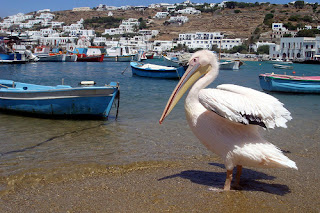Petros the Pelican
- An old celebrity of the town's waterfront, "Petros" has been the official mascot of Mykonos for many years. Found after a storm in 1954 the pelican gave up its migrating to become a local resident. After more than thirty years of making the island his home, Petros eventually died. The loss of such a personality was so deeply felt by both Mykonian and tourist alike that a replacement was soon found and a tradition established. Through the care and protection of the islanders, the spirit of Petros lives on in his predecessor who continues to this day to make his home on the island's waterfront.
Windmills
- From as early as the 16th century, one of the most recognized landmarks of Mykonos have been its windmills. Due to its geographic position, Mykonos was situated on major sea trade-route which at one time joined Venice, the gateway of Europe, to Asia. The need to refine grain and compact it for transport combined with an ample year round supply of wind made Mykonos the perfect location. Easy access to the harbor was necessary so most of the island's mills were positioned in or around the main port with the highest concentration covering the entire western portion of town. With the coming of industrialization the windmills importance began to decline as well as their numbers. Today only a fraction remains of what was once an active era in Mykonian history.
Little Venice
- Where the most western part of the town meets the sea is the area known as "Little Venice". Here the buildings have been constructed right on the sea's edge with their balconies overhanging the water. During the 16th and 17th century pirating was common and it is believed this area was used for the necessary quick loading and unloading of goods.
Paraportiani
Paraportiani - One of the most famous architectural structures in Greece is the church, Paraportiani. Positioned near the main harbor entrance, this church is the central feature of the "Kastro" or castle area, the oldest section of town. It's name means inner or secondary door which it was to the Medieval stone walls which encircled the area. First begun in 1475, Paraportiani in reality is a group of five smaller churches which were constructed over a period of time and not completed until well into the 17th century. The two story structure was molded together utilizing four of it's churches to form a base for the fifth church which when placed on top formed a central domed roof.
Delos
Delos - One of Greece's most famous archaeologic sites is the small island of Delos. Under the jurisdiction of Mykonos and situated just 2 kilometers to the west the entire island has been declared a national museum. Access to the island has been made readily available through excursions which leave daily from the main harbor of Mykonos and some of the more popular beaches.
The Armenistis Lighthouse
The Armenistis Lighthouse - Built in 1891, the Armenistis Lighthouse is situated on the north-western tip of Mykonos, overlooking the strait that separates the island of Tinos from Mykonos. Due to its high elevation the view from this location is a particularly memorable scenic attraction. Specifically the lighthouse design is an octagonal cylindrical stone tower with lantern and gallery at an overall height of 19 meters (62 ft). Its focal plane is 184 meters (604ft) with a white beacon flash every 10 seconds. The original Fresnel lens when replaced was put into a replica lantern house which is now on display in the garden of the Aegean Maritime Museum in Mykonos Town. At a distance of approximately 6 km from town, the lighthouse can be reached by taking the north coastal road that passes through both San Stephanos and the Houlakia Bay area.
The Monastery of Panagia Tourliani
The Monastery of Panagia Tourliani southeast of town dates from the 18th century and has a marble bell tower with intricate folk carvings. Inside the church are a huge Italian baroque iconostasis (altar screen) with icons of the Cretan school; an 18th-century marble baptismal font; and a small museum containing liturgical vestments, needlework, and woodcarvings.
Monastery of Paleokastro
One kilometer (1/2 mile) southeast is the 12th-century Monastery of Paleokastro, in one of the island's greenest spots. Ano Mera also has the island's most traditional atmosphere; a fresh-produce market on the main square sells excellent local cheeses. This is the island's place of choice for Sunday brunch.
Greek maritime Museum
The museum aims to undertake the preservation, promotion and study of Greek maritime history and tradition and specializes in the merchant-ship history of the Aegean Sea. The Aegean Maritime Museum was the first ever Greek museum to restore living historical exhibits as they were originally designed and built. Exhibits that are living restorations include the "Armenistis" lighthouse (built in 1890), which stands in the museum garden, and the ships Thalis o Milesios (built in 1909) and Evangelistria (built in 1940), which are located on the museum wharf at the Paleo Phaliro marina.The garden of the Aegean Maritime Museum, aside from displaying the lighthouse, has a number of ancient sailors' marble gravestones collected from the islands of Mykonos and Delos.
Lena's House
Lena's House is an authentic and traditional house of Chora, Mykonos Greece. The house was donated by Lena and the interiors exhibits items and furniture from a century ago
























